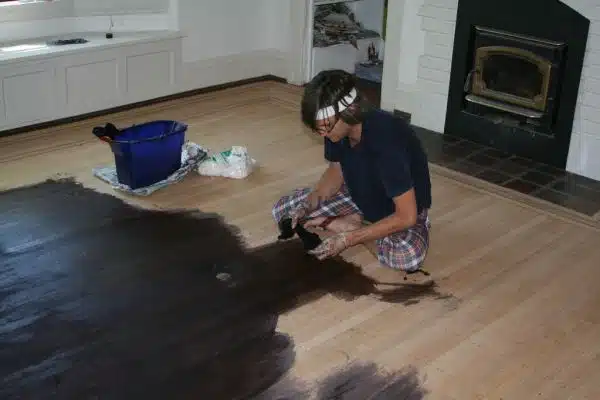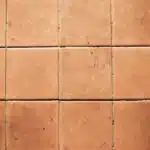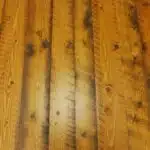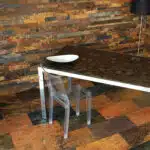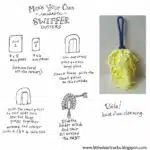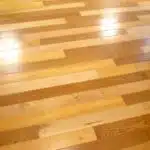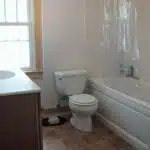Maintaining a clean and hygienic environment is crucial for the well-being of any household or workplace. The floor, being one of the most frequently used surfaces in any setting, requires regular cleaning to prevent the accumulation of dust, dirt, and germs. However, determining how often floors should be mopped can be a challenging task as it depends on various factors such as the type of flooring, foot traffic, and level of soiling.
As a cleaning expert, it is essential to understand the importance of maintaining clean and healthy floors. Neglecting this aspect can lead to the spread of diseases and infections, which can have severe consequences for individuals’ health. Therefore, in this article, we will explore some factors that affect how often floors should be mopped and provide some practical tips to help you maintain clean and hygienic floors in your home or workplace.
The Importance Of Clean Floors
Did you know that unclean floors can harbor up to 400 times more bacteria than a toilet seat? This startling fact highlights the importance of hygiene and proper floor maintenance. Not only can dirty floors be unsightly, but they can also pose health risks to those who come into contact with them. In addition to bacteria, floors can accumulate dust, dirt, and other debris that may cause respiratory issues for individuals with allergies or asthma.
Preventing floor damage is another crucial reason why maintaining clean floors is essential. Dirt and debris can scratch and wear down flooring over time, leading to costly repairs or replacements. Regular mopping not only removes surface-level grime but also helps prevent deeper damage from occurring. Neglecting proper cleaning techniques may result in permanent stains or discoloration, which could lower property values for both residential and commercial spaces.
As cleaning experts, we understand the importance of serving others by providing safe and healthy environments. Maintaining clean floors is a simple yet effective way to achieve this goal. By keeping floors sanitized and free of debris, you can help prevent the spread of harmful bacteria while prolonging the lifespan of your flooring investment. Understanding your flooring type is the first step in developing an effective cleaning routine that will protect both your property and those who utilize it daily.
Understanding Your Flooring Type
Clean floors are not only important for aesthetics, but also for hygiene and safety reasons. Proper flooring maintenance is crucial in prolonging the life of your floors, as well as maintaining a healthy living environment. Knowing how often to mop your floors is a common question among homeowners and facility managers.
The frequency of mopping depends on various factors such as foot traffic, type of flooring, and presence of spills or stains. For high-traffic areas such as entryways, hallways, and kitchens, it is recommended to mop at least once a day or more frequently if necessary. Low-traffic areas like bedrooms may only require weekly mopping.
To ensure proper cleaning and avoid damage to your flooring, it is important to understand the characteristics of your specific flooring type. Hardwood floors require different care compared to tile or carpeted flooring. Understanding your flooring type can help you determine the best cleaning tips and products to use.
Flooring maintenance can be time-consuming and challenging, but following these cleaning tips can make the task easier and more efficient:
- Use a microfiber mop for better dirt absorption
- Sweep or vacuum before mopping to remove loose debris
- Use hot water with a neutral pH cleaner specifically designed for your flooring type
- Change mop water frequently to avoid spreading dirt
- Dry the floor thoroughly after mopping to prevent water damage
Factors affecting mopping frequency include the number of occupants in a space, pets in the household, presence of children or elderly individuals who may be more prone to spills or accidents, weather conditions outside that may bring in more dirt or moisture, and any special events or gatherings that may require extra cleaning attention. Being aware of these factors can help you determine how often your floors need to be mopped for optimal cleanliness and hygiene.
Factors Affecting Mopping Frequency
As cleaning experts, we understand the importance of maintaining a clean and hygienic environment. One of the most important tasks in this regard is mopping floors. However, determining how often floors should be mopped can be a tricky task. Factors affecting mopping frequency include foot traffic, soiling levels, weather conditions, and type of flooring.
Foot traffic is one of the most important factors to consider when deciding how frequently to mop floors. A high-traffic area such as a commercial kitchen or a hospital ward may require daily mopping to maintain hygiene standards. On the other hand, low-traffic areas such as an office or residential setting may only require weekly or bi-weekly mopping. It’s essential to assess your specific needs based on foot traffic patterns to determine the optimal frequency for mopping.
Soiling levels also play a crucial role in determining how often floors should be mopped. Areas with heavy soiling such as restrooms or kitchens will require more frequent cleaning than areas with lighter soiling levels such as hallways or waiting rooms. In addition, weather conditions can also affect soiling levels by tracking in mud and dirt from outside. Therefore it’s essential to take into account both foot traffic and soiling levels when deciding on an effective mopping schedule.
Tips for efficient mopping include using proper cleaning solutions and equipment suitable for your flooring type, spot-cleaning spills immediately before they have time to set-in, avoiding over-saturating floors which can cause damage over time, changing mop heads regularly to avoid cross-contamination and reducing the risk of slip-and-fall accidents. By considering these factors and adopting these tips for efficient mopping practices you’ll ensure that your floors remain clean, hygienic and safe at all times.
Transitioning into subsequent section: Foot traffic and soiling levels are just two of several factors influencing how frequently you should mop your floors. Let’s dive deeper into each factor to help you make the best cleaning decisions for your space.
Foot Traffic And Soiling Levels
Factors affecting mopping frequency are crucial in determining how often floors should be mopped. While it is important to achieve clean floors, excessive mopping can also lead to floor damage. One of the factors that affect mopping frequency is foot traffic and soiling levels. Hence, it is essential to understand cleaning tips that can help maintain clean floors while preventing damage.
Foot traffic and soiling levels play a significant role in determining the frequency at which floors should be mopped. Floors with high traffic areas require more frequent mopping than low traffic areas. Additionally, the type of flooring material used also affects how often the floor needs to be cleaned. For example, tiles may require more frequent cleaning than carpets as they accumulate dirt and debris faster.
To effectively clean floors without causing damage, it’s important to consider various cleaning tips such as using the right cleaning agents, avoiding excess water on the floor, and using microfiber mop heads instead of traditional cotton mop heads. These tips help maintain a balance between achieving clean floors and minimizing damage. Additionally, preventive measures such as placing doormats at entryways and regular sweeping can help reduce soiling levels, thereby reducing the frequency of mopping.
- Use pH-neutral cleaners for natural stone flooring
- Use less water when cleaning hardwood or laminate flooring
- Avoid using bleach or ammonia-based cleaners on vinyl flooring
- Consider using a floor finish or sealant for high traffic areas
With proper consideration of foot traffic and soiling levels, coupled with appropriate cleaning tips, maintaining clean floors while preventing damage becomes achievable. In the next section, we will discuss pet and allergen considerations that also influence how often floors should be cleaned.
Pet And Allergen Considerations
Pet and Allergen Considerations:
When it comes to keeping a clean floor, pet hair removal should be at the top of your priority list. Pets shed their hair frequently, which can accumulate on floors and cause allergic reactions to those who suffer from pet allergies. To prevent this from happening, it is recommended that you vacuum or sweep up pet hair every day. You can also use a lint roller or wet mop to pick up any stray hairs that may have been missed.
Allergy prevention is another important consideration when it comes to cleaning floors. Dust and allergens can easily accumulate on hard surfaces and carpets, leading to sneezing, coughing, and other allergy symptoms. To reduce the risk of allergies in your home, make sure to clean your floors regularly with a high-quality vacuum cleaner or mop. You may also want to invest in an air purifier that can help remove airborne allergens from your indoor environment.
In addition to daily cleaning routines for pet hair removal and allergy prevention, it is important to take extra steps when dealing with more stubborn stains or spills on floors. For example, if you have hardwood floors, you should avoid using harsh chemicals that could damage the surface. Instead, opt for a mild soap solution or vinegar and water mixture that will effectively clean the area without harming the finish. If you have carpeted floors, it’s best to blot up any spills immediately with a clean cloth before they set in too deeply.
Moving onto surface material and stains…
Surface Material And Stains
When it comes to maintaining the cleanliness of surfaces, particularly floors, it’s important to consider the material and potential stains that may occur. Different materials require different cleaning methods and solutions. For example, a tile floor may require a stronger cleaning solution than a hardwood floor. It’s important to choose the right cleaning solution for your specific surface material in order to effectively remove any stains or dirt buildup.
Removing stubborn stains can be a frustrating task for anyone tasked with cleaning floors. However, there are several effective methods for removing even the most difficult stains. One option is to use a combination of baking soda and vinegar to create a natural cleaning solution. Another option is to use commercial stain removers specifically designed for your type of flooring material. Regardless of which method you choose, it’s important to act quickly when dealing with stains in order to prevent them from setting into the surface.
Choosing the right cleaning solution can make all the difference when it comes to maintaining clean floors. Be sure to read labels carefully and choose products that are safe for your specific type of flooring material. Additionally, always spot test any new cleaning solution before using it on an entire surface area in order to avoid damaging your floors. By taking these steps, you can ensure that your floors remain free from stubborn stains and buildup while also keeping them looking their best over time.
Transition: Now that we’ve covered some tips for removing stubborn stains and choosing the right cleaning solutions, let’s dive into recommended mopping schedules for hardwood floors.
Recommended Mopping Schedule For Hardwood Floors
According to a study conducted by the National Sanitation Foundation, floors can harbor up to 4000 bacteria per square inch. With this in mind, it is essential to maintain a regular cleaning schedule for your hardwood floors. The ideal mopping frequency depends on various factors like foot traffic, pets, and the presence of kids in your home.
If you have a high-traffic area, it is best to mop your hardwood floors once every day or two. However, suppose you have lower foot traffic areas like bedrooms or guest rooms. In that case, you can mop them once a week or whenever you notice visible dirt or stains. Using natural cleaning solutions like vinegar and water will prevent any damage caused by harsh chemicals.
DIY cleaning tips are readily available online for those who prefer a more hands-on approach to their cleaning routine. It is important to note that over-mopping your hardwood floors can lead to water damage and potentially ruin the finish of the flooring. As such, it’s best not to overdo it when mopping your hardwood floors.
In summary, keeping a regular cleaning schedule for your hardwood floors is vital to maintain a healthy living space. Depending on the level of foot traffic and other factors unique to your home environment, mopping frequency may vary from daily to weekly. Natural cleaning solutions are recommended for protecting the flooring’s finish while ensuring optimal hygiene levels at all times. Next up, we will discuss the recommended mopping schedule for tile and grout in further detail.
Recommended Mopping Schedule For Tile And Grout
The frequency of mopping tile and grout floors should be dependent upon the amount of traffic in the area, with high traffic floors requiring more frequent mopping.
Cleaning solutions for tile and grout should be chosen based on the type of tile and grout, as well as the desired outcome.
A general rule of thumb for mopping tile and grout floors is to mop them at least once a week, but more frequently in areas with heavy foot traffic.
The use of vinegar and water, mild detergent and water, or a pre-mixed grout cleaner is the best way to ensure the tile and grout are properly maintained.
Frequency Of Mopping
Maintaining a clean and polished floor is an essential part of any household or commercial place. However, the frequency of mopping depends on various factors affecting the optimal frequency. Factors like foot traffic, weather conditions, and type of flooring material play a significant role in determining how often floors need to be mopped.
Foot traffic is one of the crucial factors that determine how often floors should be mopped. High-traffic areas such as hallways, entryways, and kitchens require more frequent mopping than low-traffic areas like bedrooms or guest rooms. Weather conditions also play a role in determining the optimal frequency for mopping. Wet weather can lead to dirty tracks and mud on your floor that may require more frequent cleaning. Additionally, the type of flooring material used plays an essential role in deciding how often it needs to be cleaned.
In conclusion, there is no one-size-fits-all answer when it comes to determining how often floors should be mopped as several factors affect the optimal frequency. Understanding these factors can help you decide how frequently you need to perform this task. Regular maintenance not only keeps your floor looking clean but also extends its longevity and durability, making it an essential aspect for maintaining a healthy environment at home or work.
Cleaning Solutions For Tile And Grout
When it comes to maintaining tile and grout, regular cleaning is essential. However, simply mopping may not be enough to keep them looking their best. Over time, dirt and grime can build up in the grout lines, making them appear dull and discolored. To combat this, it’s important to use appropriate cleaning solutions that are safe for both the tile and the grout.
One effective way to clean tile and grout is by using natural cleaning products. These products are typically made from ingredients like vinegar, baking soda, or lemon juice and are a great alternative to harsh chemical cleaners. Not only are natural products better for the environment, but they also tend to be gentler on surfaces like tile and grout.
Another important step in maintaining tile and grout is to seal the grout lines periodically. Grout sealing techniques involve applying a protective layer over the grout that helps repel water, dirt, and other substances that can cause stains or discoloration. This can help prolong the life of your tile and prevent costly repairs down the line. When choosing a sealer, be sure to select one that is compatible with your specific type of tile and grout for best results.
Recommended Mopping Schedule For Carpeted Floors
Carpeted floors are an excellent choice for those looking to add warmth and comfort to their homes. However, maintaining the cleanliness of carpeted floors can be challenging, especially in high-traffic areas. Carpeted floor maintenance involves regular cleaning to keep the flooring in top condition.
To keep your carpets looking their best, it is recommended to vacuum them at least once a week, or more frequently if you have pets or children. Vacuuming removes surface dirt and debris that may cause damage to the carpet fibers over time. Additionally, regular vacuuming helps prevent stains from settling into the carpet.
Deep cleaning your carpets should be part of your regular maintenance routine. This process involves using a steam cleaner or hiring professionals to thoroughly clean your carpets. Deep cleaning removes embedded dirt and grime that cannot be removed through vacuuming alone. It helps prolong the life of your carpets and keeps them looking fresh and new.
Carpeted floor maintenance is essential for keeping your home clean and comfortable. Regular vacuuming and deep cleaning tips should be followed for optimal results. In our next section, we will discuss the best types of mops for different flooring types that can help you maintain a spotless home with ease.
Best Types Of Mops For Different Flooring Types
When it comes to maintaining a clean and hygienic environment, choosing the right type of mop is crucial. Different flooring types require different methods of cleaning to ensure their longevity and cleanliness. Two popular options are steam mops and microfiber mops for their efficacy in removing dirt and grime.
Steam mops are an excellent choice for hard flooring surfaces such as tile, hardwood, and laminate. They use steam to break down dirt and grime, sanitizing floors without the need for harsh chemicals. Microfiber mops, on the other hand, work well on a variety of surfaces including wood, tile, and linoleum. They require less water than traditional wet mops and can easily pick up dust and debris.
Another factor to consider is whether to use dry or wet mops. Dry mops are ideal for removing loose dust particles from floors that can cause allergies or respiratory problems. Wet mops use water or a cleaning solution to penetrate dirt buildup on floors but can damage some flooring types if not used correctly.
To make the right choice when selecting a mop type, it is important to understand what works best with each floor surface. Taking care of your floors means taking care of your home or office space. A clean environment fosters productivity and promotes health among those who occupy it. In the next section, we will explore proper techniques for maximum effectiveness when using different types of mops on various flooring surfaces.
Proper Mopping Techniques For Maximum Effectiveness
Anticipated objection: “Mopping takes too much time and effort.”
Proper mopping techniques are crucial to effectively clean floors. While some may view it as a time-consuming and laborious task, proper technique can result in a quicker and more efficient cleaning process. The frequency at which floors should be mopped depends on the level of foot traffic they receive. High-traffic areas such as lobbies or kitchens should be mopped daily, while lower-traffic areas such as private offices can be mopped weekly.
To maximize effectiveness, it is important to use the appropriate cleaning solutions for each type of flooring. Hardwood floors require a cleaner specifically designed for wood, while tile floors can benefit from an all-purpose cleaner. It is essential to read labels carefully and follow instructions to avoid damage to the floors or harm to individuals using them.
A table comparing different types of floor surfaces and recommended cleaning solutions is provided below:
| Floor Surface | Cleaning Solution |
|---|---|
| Hardwood | Wood-specific cleaner |
| Tile | All-purpose cleaner |
| Carpet | Carpet shampoo |
By implementing proper mopping techniques and utilizing appropriate cleaning solutions, maintaining clean floors becomes less daunting. In the subsequent section, we will discuss eco-friendly cleaning solutions that not only benefit the environment but also promote healthier living spaces.
Eco-Friendly Cleaning Solutions For Floors
Proper mopping techniques are essential for maintaining a clean and hygienic environment. However, the type of cleaning solution used can also have an impact on the effectiveness and sustainability of the cleaning process. For those who are environmentally conscious, using eco-friendly cleaning products is an excellent way to reduce their carbon footprint and minimize exposure to harmful chemicals.
Eco-friendly cleaning products are made from natural ingredients that are safe for both people and the environment. They are free from harsh chemicals such as bleach, ammonia, or phosphates, which can cause skin irritation or respiratory problems when inhaled. Instead, they use natural ingredients like vinegar, baking soda, or lemon juice to clean floors effectively. DIY cleaning solutions using these ingredients are easy to make at home and can be customized according to personal preferences.
Using eco-friendly cleaning products not only benefits the environment but also helps save money in the long run. Traditional chemical-based cleaners can be expensive and require frequent replacement due to their harsh nature. In contrast, DIY all-natural solutions cost less and can be easily stored in reusable containers for future use.
In conclusion, incorporating eco-friendly cleaning solutions into your mopping routine is a great way to achieve maximum effectiveness while minimizing harm to the environment. By using natural ingredients like vinegar or lemon juice instead of harsh chemicals like bleach or ammonia, you can maintain a clean and healthy living space without breaking the bank. Next up: common mistakes to avoid when mopping for optimal results!
Common Mistakes To Avoid When Mopping
Mopping is a vital chore that helps maintain the cleanliness and hygiene of our living spaces. However, it can be easy to make mistakes while doing it. Common mistakes include over-wetting the floors and using dirty water for cleaning. These errors can lead to an unsatisfactory outcome with floors looking dull, streaky, and unclean.
One effective way to prevent such damage is by using the right cleaning solution. A good cleaning solution not only eliminates dirt and grime but also maintains the quality of your flooring material. Harsh chemicals should be avoided as they can cause discoloration or even damage certain types of floors. It is essential to read the manufacturer’s instructions before selecting a cleaning solution.
Another common mistake people make while mopping is using dirty water. This can spread bacteria and germs around your home, defeating the purpose of cleaning in the first place. It is recommended that you change your mop water regularly while mopping different areas of your home to prevent this from happening.
Incorporating these tips into your mopping routine will help achieve cleaner and healthier living spaces for everyone in your household. However, maintaining clean floors in high-traffic areas requires additional care and attention that we will discuss in our subsequent section.
Maintaining Clean Floors In High-Traffic Areas
Maintaining clean floors in high-traffic areas can be a challenging task, but it is not impossible. If you have a kitchen that sees a lot of foot traffic, you should aim to mop the floors at least once per day. However, if your kitchen is not as busy, mopping every other day should suffice. For entryways, it is best to sweep or vacuum daily and mop at least twice per week.
To keep your floors clean in between moppings, there are a few tips you can follow. First, place doormats at all entrances to catch dirt and debris before it gets tracked onto your floors. Second, encourage family members or employees to remove their shoes upon entering the home or workplace. Third, wipe up spills immediately before they have a chance to dry and become harder to clean.
Regular floor cleaning is essential for maintaining cleanliness and preventing the buildup of dirt and grime. However, for those who lack the time or resources to maintain their own floors adequately, professional floor cleaning services are an excellent option. These services can provide deep cleaning that goes beyond what regular mopping can accomplish and can help extend the life of your flooring materials. In the next section, we will explore the benefits of these services in more detail.
Benefits Of Professional Floor Cleaning Services
Maintaining clean floors in high-traffic areas is crucial for the safety and hygiene of any establishment. While regular sweeping and spot cleaning can help maintain a certain level of cleanliness, mopping is an essential part of floor maintenance. But how often should floors be mopped? The frequency of mopping depends on several factors such as foot traffic, type of flooring, and the presence of spills or stains.
Floor cleaning benefits extend beyond just aesthetic appeal. Regular mopping helps to remove dirt, dust, and other allergens that can accumulate on the surface over time. It also prevents the growth of harmful bacteria and viruses that can cause illnesses. Professional cleaning advantages include the use of specialized equipment and techniques that ensure a thorough clean without damaging the flooring material.
Hiring professional floor cleaning services has numerous benefits for any establishment. Not only does it reduce the workload for staff members, but it also ensures that floors are cleaned effectively and efficiently. Professional cleaners have access to industrial-strength equipment and cleaning products that are not readily available to the general public. This means that they can achieve a higher level of cleanliness than what can be achieved through regular in-house cleaning methods. In addition, professional cleaners have specialized knowledge regarding different types of flooring materials and how best to clean them without causing damage.
Conclusion
Clean floors are essential for maintaining a healthy and hygienic environment in any living or working space. The frequency of mopping often depends on the type of flooring, amount of foot traffic, and soiling levels. For instance, high-traffic areas like commercial spaces may require daily or weekly mopping, while residential areas may only need to be mopped every two weeks.
When considering how often to mop your floors, it’s important to take into account factors such as pet and allergen considerations. Additionally, eco-friendly cleaning solutions can be used to minimize environmental impact while still maintaining a high level of cleanliness.
However, it’s important to avoid common mistakes when mopping such as using too much water or not properly wringing out the mop. Maintaining clean floors in high-traffic areas can also involve regular vacuuming and sweeping. Ultimately, professional floor cleaning services can provide a deeper level of cleanliness and ensure that your floors are well-maintained for longer periods.
In conclusion, keeping floors clean is crucial for ensuring a healthy living or working environment. By understanding the factors affecting mopping frequency and avoiding common mistakes, you can maintain clean floors in both residential and commercial settings. So why wait? Start mopping today and enjoy the benefits of fresh-smelling floors that look their best!
Image Credits
- “ebony stain on oak floors how-to (read this first: i.e. our floor nightmare)” by ninahale (featured)

